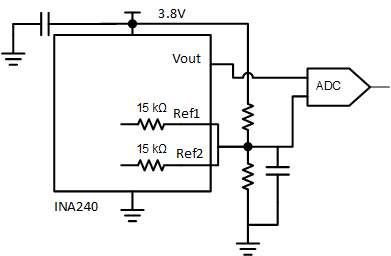Other Parts Discussed in Thread: ADS1115
I want to build something similar to:
TI Designs: TIDA-03040
Automotive Shunt-Based ±500-A Precision Current Sensing Reference Design
www.ti.com/.../tiducj6a.pdf
But instead of the PGA400, I want to just use a 16-bit ADC (ADS1115).
Our board has a regulated 3.8V supply.
Plan is to use a voltage divider to divide 3.8V by 2 for the reference voltage. Does this need to be buffered or is a simple resistive voltage divider OK?
The output of the INA240A1 would then be 0.9-2.9V. Followed by a 1/4 voltage divider gives me 0.225-0.725V, which is perfect for the ADS1115 +-0.256V differential input.
Does the reference voltage need to be super precise? I mean let's say it drops from 3.8V to 3.4V, then the input to the ADS1115 would become 0.175-0.675V. But since the ADS1115 is measuring differentially, wont the result still be the same?
Another scenario is that my board could be powered by a 3.6V battery. And if I use it divided by 2 for the reference voltage it would vary as the battery discharges. This goes back to my question above on if it matters if the reference voltage is not stable when going into a differential ADC?
Thanks for the help.


